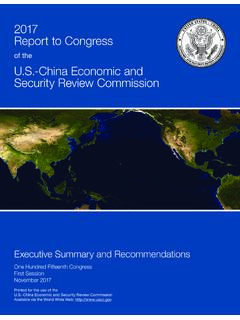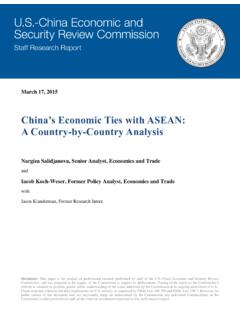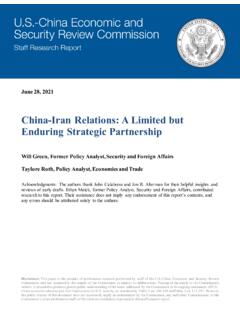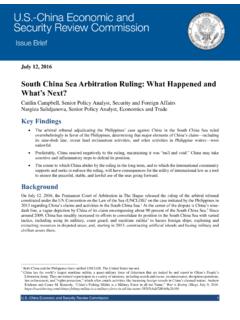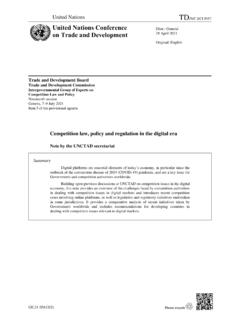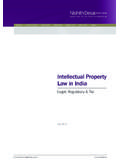Transcription of Chinese Companies Listed on Major U.S. Stock Exchanges
1 Las t updat e d: May 5, 2021 1 Chinese Companies Listed on Major Stock Exchanges This table includes Chinese Companies Listed on the NASDAQ, New York Stock Exchange, and NYSE American, the three largest As of May 5, 2021, there were 248 Chinese Companies Listed on these Exchanges with a total market capitalization of $ trillion. On October 2, 2020, when this table was last updated, there were 217 Companies with a total market capitalization of $ trillion. In the list below, newly added Companies are marked with a section symbol ( ) next to the Stock Companies are arranged by the size of their market cap.
2 There are eight national-level Chinese state-owned enterprises (SOEs) Listed on the three Major Exchanges . In the list below , SOEs are marked w ith an asterisk (*) next to the Stock Since this table was last updated in October 2020, 17 Chinese Companies have delisted. Two Companies currently trade over the counter: Kingold Jewelry (KGJI, $3 million market cap) and state-owned Guangshen Railway (GSHHY, $2,256 million market cap). The 17 delisted Companies also include four Companies targeted by the Executive Order 13959 ( Addressing the Threat from Securities Investments That Finance Communist Chinese Military Companies ), which prohibited investment in Communist Chinese Military Companies .
3 These are: China Unicom, China Telecom, China Mobile, and CNOOC Limited. In addition, Semiconductor Manufacturing International Corporation (SMIC) stopped trading over the counter as a result of the The remaining company subject to the order is Luokung Technology Corp. (see listing 101).2 Luokung s delisting by NASDAQ was postponed following a preliminary injunction granted by the District Court for the District of Columbia on May 5, This list of Chinese Companies was compiled using information from the New York Stock Exchange, NASDAQ, commercial investment databases, and the Public Company Accounting Oversight Board (PCAOB).
4 4 NASDAQ information is current as of February 25, 2019; NASDAQ no longer publicly provides a centralized listing identifying foreign-headquartered Companies . For the purposes of this table, a company is considered Chinese if: (1) it has been identified as being from the People s Republic of China (PRC) by the relevant Stock exchange; (2) it lists a PRC address as its principal executive office in filings with Securities and Exchange Commis s ion; or (3) it has a majority of operations in the PRC, including Companies structured offshore but whose value is ultimately tied through a relationship in the PRC.
5 Of the Chinese Companies that list on the Stock Exchanges using offshore corporate entities, some are not transparent regarding the primary nationality or location of their headquarters, parent company or executive offices. In other words, some Companies which rely on offshore registration may hide or not identify their primary Chinese corporate domicile in their listing information. This complicates tr ac ing, making it difficult to guarantee that this list captures all Chinese Companies registered offshore. Companies domiciled exclusively in Hong Kong also are not included on this list. If information on the company s IPO year, IPO value, or underwriters is not available, the field is marked n/a.
6 Investment in Chinese Companies may entail several risks associated with the legal, regulatory and financial environment in mainland China, including: Lack of transparency: The PCAOB, a nonprofit corporation established by Congress to oversee the audits of publicly traded Companies Listed on Exchanges , is currently unable to inspect working papers of auditors based in the PRC and Hong Kong. In 2013, the PCAOB signed a Memorandum of Understanding (MOU) on audit oversight with the China Securities Regulatory Commission and the Ministry of Finance. Over the next seven years, the Chinese government has prevented Chinese -based auditing firms from complying with law on audit The PCAOB and the Securities and Exchange Commission have repeatedly expressed their i There are currently 13 Exchanges in the United States, 12 of which are owned by NASDAQ, NYSE, or CBOE.
7 Only NASDAQ and NYSE rank in the top 70 Exchanges globally. ii Some Companies added in this update had an IPO prior to the last update (October 2, 2020). These Companies were identified through the use of Cap it alIQ. iii This list is drawn from the directory of SOEs published by the State-o wned A sset s Su pervisio n and A dmin is tratio n Co mmis s io n o f the People s Republic of China s State Council. An archived version of the SASAC s directory is available here: h ttp s://web .archiv rg/web /20191208080817/en .s names .html. Las t updat e d: May 5, 2021 2 concern regarding obstacles to PCAOB inspection of auditors based in the PRC and Hong Kong.
8 In the past year, th e P CAO B reported 252 audit reports issued by or relying on referred work from PCAOB-registered firms in jurisdictions where authorities deny access to conduct inspections. All of these firms are based in China and Hong This lack of compliance with international audit inspections calls into question the r eliability of the corporate financial statements guiding valuation and investment. The case of Luckin Coffee illustrates the risks. In presenting information to support its initial public offering, Luckin manipulated critical revenue, operations and customer traffic data. During its IPO, shares traded at $17 raising $561 million in Luckin s peak market capitalization was $12 billion, with shares trading at just over $ Within weeks of the disclosure of falsified information, the Stock collapsed ultimately leading to losses for investors and its delisting from The legal standing of VIEs in China is unclear: The PRC legally prohibits foreign direct investment in certain industries, including many high-tech sectors, and maintains strict controls on foreign exchange and capital flows.
9 To circumvent these restrictions, mainland Chinese Companies interested in raising funds on Exchanges create offshore corporate entities for foreign investment using a complex structure called a variable interest entity (VIE).v In a March 2019 survey of 182 Chinese Companies Listed on NYSE and NASDAQ, Paul Gillis, professor of practice at Peking University Guanghua School of Management, found that 125 of these Companies used the VIE VIE arrangements between mainland Companies and their associated offshore entities have questionable status under Chinese laws. In February 2021, the State Administration for Market Regulation (SAMR) issued new guidelines for the platform economy establishing that VIEs are formally covered by China s Anti-Monopoly Law, which requires Companies to seek SAMR approval for mergers and , 10 Ac c or ding to Mr.
10 Gillis , the broader impact of this law on the legality of existing VIE structures is unclear s inc e the guidelines may not represent a meaningful change in China s approach to VIEs. 11 The unresolved standing of the VIE structure under Chinese law means investors could have no recourse to enforcement in the Chinese legal system if VIE-lis ted Companies take the company private at lower valuationvii or if the businesses fail. According to Steve Dickinson and Dan Harris, co-authors of the China Law Blog and attorneys focusing on Chinese law, there is an additional risk related to VIEs. Since they have questionable legal status in China, the government could take action to close or control National security risk: Investors in Chinese Companies may support activities that are contrary to national interests, including the development of technology used for censorship and surveillance and in support of the military.

